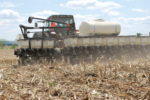Advertise Follow Us
Items Tagged with 'Higher yields'
ARTICLES
‘Fencerow Farming’ Can Lead To Higher Yields, Better Soil Health
Dean Glenney’s 18 years of no-tilling attracted beneficial bacteria and increased his supply of ‘free’ fertilizer, creating record-breaking no-till corn yields in Ontario.
Read More
Emerging Biologicals Could Help No-Tillers Get More With Less
Bio-ag products are outgrowing their “snake oil” reputation and could bring higher yields at a lower environmental price.
Read More
No-Till Notes
Building A Better No-Till Soil
Gypsum, cover crops, manure and even vertical tillage can be part of a multifaceted no-till system that improves soil health and brings in higher yields.
Read More
Cutting-Edge Planting And Seeding Equipment
Options, flexibility and precision are hallmarks of the new planters and drills unveiled at the 2009 Farm Progress and Big Iron shows
Read More
Is Ripping Necessary With No-Till?
Deep ripping may have a place, but it isn’t the answer to yield concerns due to erosion and compaction in all no-tilled fields.
Read More

.png?height=125&t=1731942302&width=150)





